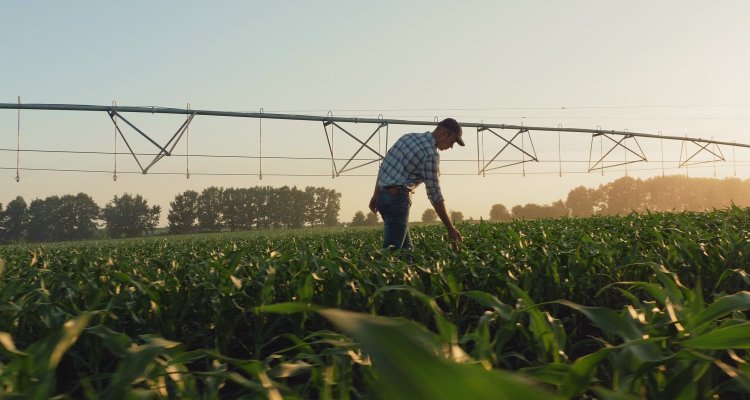
News
How can we ensure the safe usage of waste streams?
In the Circular Connected programme, four research teams from Wageningen University & Research (WUR) are working together in Flagship projects to jointly shape the transition to a circular food system: a food economy based on organic materials where nothing is wasted.
In a series of articles, the leaders of this programme talk about their vision of the circular food system of the future. Today, Bjorn Berendsen talks about Flagship 2: Ensuring Quality and Safety. How can we ensure the safety of our food and the planet’s ecosystems in a circular food system? “We defined seven key questions that need to be answered to identify the risks of using waste streams.”
A circular food system sounds like a dream come true, but reusing waste streams also carries risks, such as the potential spread of pathogens or the accumulation of heavy metals. Therefore, the Flagship 2 project aims to develop a tool to help manage the safe usage of waste streams on time. “Safety aspects are often only considered after a design has been completed,” says research associate Bjorn Berendsen. “We propose starting with safety and considering it from a ‘One Health Perspective’, where dangers to humans, animals and ecosystems carry equal weight. The production of safe food should not come at the expense of ecosystems or biodiversity.”
HACCP and beyond
HACCP (Hazard Analysis and Critical Control Points), the standard in food risk assessment, is a good starting point here. “We formulated seven questions to fine-tune the HACCP methodology specifically geared to waste streams,” continues Berendsen (see box). “It is important to harmonise with existing systems to increase the likelihood of people actually using our tool. These seven questions help to focus the identification of critical points in a circular system.”
Seven questions
Seven additional questions to assess the risks of using waste streams:
- Which raw materials and waste streams are processed?
- What potential hazards (chemical, microbiological or physical) does the waste stream pose?
- Will these hazards decrease during processing or will processing cause new hazards?
- How are hazards transferred between the various systems (e.g. from animals via manure to soil, plants and water)?
- Are the hazards reduced by natural mitigation within the system or are they persistent?
- Do the hazards pose a potential risk (One Health Perspective) to the systems in which they may occur?
- Are these potential risks acceptable or can they be actively mitigated (preferably at the source)?
Answering these seven questions sounds simple, but that is certainly not the case, Berendsen stresses. “In many cases, we lack the knowledge we need due to the complexity of the food system.” The researchers distinguish four production systems: animal, plant, packaging and aquaculture. “What makes it so complex is that these circular food production systems are interconnected, and so the risks can be transferred between them, spreading to the entire food system. A hazard introduced in one place may lead to a risk elsewhere.”
Acute hazards and long-term risks
A case study that reflects the complexity of this area of research, and is currently highly topical, is manure. Manure introduces nutrients to agricultural land and so prevents it from becoming depleted. Currently, there is ample organic manure available in the Netherlands. Artificial fertilisers from fossil sources, the alternative to organic manure, are preferably avoided in circular food systems. But, given the current political debate, the production of organic manure is likely to decline sharply in the future. “A possible alternative could be human manure, a currently unused waste stream,” says Berendsen. “This is where our seven key questions come into the picture. For example, does human manure contain pathogens or microplastics? And what to do with traces of medicines? This case study makes it immediately clear how much knowledge we still need to gain to answer these questions. It also reveals how risks are transferred: manure is applied to the soil, and substances in it can be passed on to ground and surface water or crops. To accurately determine the hazards this entails, we need to know exactly where the waste streams end up. And we need to know if those traces of medicines accumulate somewhere in the system or are in fact broken down, for example. The whole system is interconnected. We also need to give as much attention to acute hazards like pathogens as we do to long-term risks like microplastics and PFAS.”
Waste stream safety research contributes directly to the transition
Flagship 2 has revealed that the original research question (How can we ensure the safety of our food and the planet’s ecosystems in a circular food system?) is much more complex than first thought. “The seven key questions offer pointers for further research,” says Berendsen. “It is important to realise that, in the Netherlands, it is the producers who are responsible for this safety. So, ultimately, the transition is also dependent on producer awareness.”
There is also the question of how much risk we as a society are willing to accept. The trend is currently zero tolerance for our food. Is that realistic? And if not, where is the limit? Research into waste stream safety can help shape this debate. Unfortunately, this often still has a negative connotation, because identifying a risk can lead to a process being shut down. But safety research can also open doors. “For example, if we can demonstrate that the use of human manure is not harmful, or how we can reduce or eliminate the risks with certain modifications, then safety research will have contributed directly to the transition.”